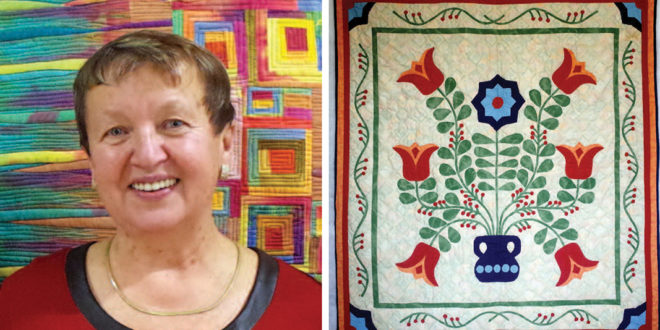By Daiva Markelis.
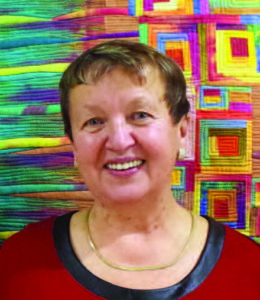
A nation’s cultural history is expressed through its folk art, and a particularly fascinating aspect of that art has to do with textiles. In the United States and Canada, the most popular textile art has arguably been quilting, encompassing an impressive artistic and geographical range that includes Amish quilts with their simple designs, the intricate star quilts of the Native Americans, and appliquéed Baltimore album quilts. In Lithuania, the predominant form of textile making was weaving. Every agrarian household had its own loom. Women wove garments and linens for the family, thus utilizing their practical skills as well as their artistic talents.
Although quilt-making has never been a traditional Lithuanian art or craft, more and more Lithuanian names are appearing in the pages of quilting magazines, of which there are seemingly hundreds. Many of these quilters create what are called art quilts. According to the Art Quilt Association, “An art quilt is an original exploration of a concept or idea rather than the handing down of a pattern. It experiments with textile manipulation, color, texture and/or a diversity of mixed media.” As opposed to traditional quilts, which often provide warmth and beauty as bed coverings, art quilts, much like paintings, are hung on walls.
 Of the Lithuanian names I’ve come across, the most well-known is Maryte Collard (her maiden name is Arlauskas), who was born and grew up in Kybartai, in the southern region of Lithuania. I first became aware of Maryte’s quilts when I picked up an issue of the influential Art Quilt Quarterly (issue Number Eleven); she was featured in the journal’s “Artists to Watch” section. I was smitten by her quilts. Maryte uses colorful log cabin blocks in her work, but the way they’re arranged is non-linear, which gives the quilts a vibrant modern feel. She explained that the short gloomy winter days in Lithuania coupled with the grim concrete of many of Lithuanian’s apartment buildings inspired her to create a world of beauty and color: “My art is a rebellion against a gray world.”
Of the Lithuanian names I’ve come across, the most well-known is Maryte Collard (her maiden name is Arlauskas), who was born and grew up in Kybartai, in the southern region of Lithuania. I first became aware of Maryte’s quilts when I picked up an issue of the influential Art Quilt Quarterly (issue Number Eleven); she was featured in the journal’s “Artists to Watch” section. I was smitten by her quilts. Maryte uses colorful log cabin blocks in her work, but the way they’re arranged is non-linear, which gives the quilts a vibrant modern feel. She explained that the short gloomy winter days in Lithuania coupled with the grim concrete of many of Lithuanian’s apartment buildings inspired her to create a world of beauty and color: “My art is a rebellion against a gray world.”
After reading the article, I did what any self-respecting art lover would do when confronted with a beautiful work of art: I Googled the artist. I discovered Maryte’s blog, which includes a portfolio of her work as well as a list of her exhibitions, most of them juried. I emailed Maryte, who graciously answered my questions. I learned that her father was a railroad worker, although she never got to know him – he died when she was five months old. Her mother struggled to raise four children. Maryte was a curious child who loved knitting, crocheting, making clothes for dolls, and drawing. Her second grade teacher once came in to talk to Maryte’s mother about sending her daughter to art school in Vilnius. “My mother couldn’t afford to send me there. Vilnius looked very far away,” she said. Maryte continued attending school in Kybartai and then graduated from Kaunas Medical Institute as a medical doctor. But art followed her throughout life.
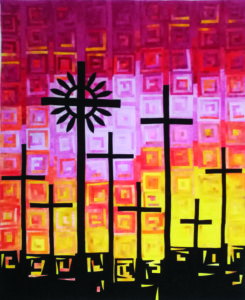 Maryte was introduced to quilting in 1997. “I started as a traditional quilter because I had no idea about art quilts,” she stated. She soon learned. She bought her first computer and started searching the internet, where she discovered Yvonne Porcella’s colorful quilts with their black and white checker board inserts. Soon Maryte was designing her own quilts. She joined the international art quilter’s organization, SAQA (Studio Art Quilt Associates), which was started by Porcella. SAQA connected her to Australian quilt artist Brenda Gael Smith, who guided Maryte’s metamorphosis into quilt artist.
Maryte was introduced to quilting in 1997. “I started as a traditional quilter because I had no idea about art quilts,” she stated. She soon learned. She bought her first computer and started searching the internet, where she discovered Yvonne Porcella’s colorful quilts with their black and white checker board inserts. Soon Maryte was designing her own quilts. She joined the international art quilter’s organization, SAQA (Studio Art Quilt Associates), which was started by Porcella. SAQA connected her to Australian quilt artist Brenda Gael Smith, who guided Maryte’s metamorphosis into quilt artist.
Many of Maryte’s quilts have a distinctly Lithuanian aesthetic. I asked about Lithuanian elements in her work. “I think my quilts are too colorful to be considered completely Lithuanian, but most of my designs are based on photos taken in Lithuania,” she said. One might also argue that her quilts are not “fussy”; their simplicity evokes the traditions of the best Lithuanian folk art. And although vivid color is a hallmark of Maryte’s quilts, she occasionally works with the more subdued hues of linen, the most traditional of Lithuanian textiles. One of her linen quilts, Song of Linen, was accepted into one of the most prestigious European art quilt contests – the European Patchwork Meeting – in Alsace, France in 2017. Maryte’s collection of linen fabrics is growing, and she plans on making a new series of linen quilts.
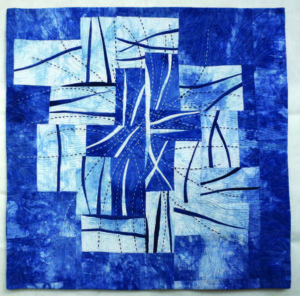 When I asked Maryte about her design process, she answered that she seldom draws her designs before quilting: “I draw when I have to figure out how to construct the quilt, how to put pieces together. Design wise, it is all in my head. Sometimes I feel it just comes out of my heart. I do use a design wall where I pin pieces to look how they work together. I move them around until I like what I see and then I start construction.” Maryte might have a photo nearby to use for color placement and mood, but she never produces an exact copy. What’s important are the colors, lines, shapes, and textures that the photograph inspires. She sometimes adds hand stitching to give a quilt more texture.
When I asked Maryte about her design process, she answered that she seldom draws her designs before quilting: “I draw when I have to figure out how to construct the quilt, how to put pieces together. Design wise, it is all in my head. Sometimes I feel it just comes out of my heart. I do use a design wall where I pin pieces to look how they work together. I move them around until I like what I see and then I start construction.” Maryte might have a photo nearby to use for color placement and mood, but she never produces an exact copy. What’s important are the colors, lines, shapes, and textures that the photograph inspires. She sometimes adds hand stitching to give a quilt more texture.
Like many well-known art quilters, Maryte dyes her own fabrics. She uses a new generation of dyes called Procion MX dyes that don’t require a lot of water or boiling. Maryte said, “I play around with dye solutions. I don’t use recipes for mixing colors, so I’m always surprised.” She added that she often gets the best outcomes when mixing colors without having a final result in mind. She sometimes paints with the same thickened dyes or uses them for screen printing or geli plate printing.
Maryte believes that although quilting is slowly gaining popularity in Lithuania, it still has a long way to go. There are quilt clubs in Vilnius, Kaunas, and Utena, but no quilt shops in the country except for a few online ones that sell craft and quilting supplies. The biggest problem has to do with quilting thread. “I’ve never bought any spool of quilting or machine embroidery thread because no one carries them,” Maryte stated. “I was very disappointed to learn that cotton thread is not available at all in Lithuania, not even simple machine sewing cotton thread.” Another issue has to do with the way that the very word “quilt” is perceived: “The Lithuanian name for quilts, skiautiniai, is mostly understood in terms of bed spreads, blankets, pillow cases, mug rugs and pot holders. Art quilts are not as well-known or admired.” A few years ago when she was asked to show her quilts in Lithuania at a senior club at the local library, Maryte realized that many of the women were not very interested in her art quilts but were drawn to the few traditional older quilts in her exhibition.
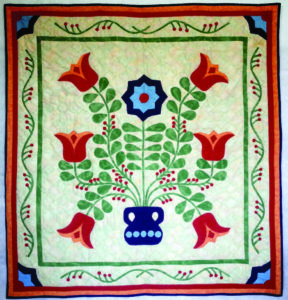 Maryte’s quilts have traveled the world to China, France, Germany, Italy, England, Ireland, Canada, the United States, and all three of the Baltic States. Her quilt Sunset on the Hill of Crosses is on its way to Verona, Italy, where it will appear in the Verona Tessile. In 2018, when the Baltic States celebrated one hundred years of independence, Maryte, along with an Estonian crafter and two Latvian ceramists, held exhibitions in Šiauliai, Parnu, and Jelgava, sister cities associated with these Baltic artists. The exhibition was titled A Present (Dovana in Lithuanian.)
Maryte’s quilts have traveled the world to China, France, Germany, Italy, England, Ireland, Canada, the United States, and all three of the Baltic States. Her quilt Sunset on the Hill of Crosses is on its way to Verona, Italy, where it will appear in the Verona Tessile. In 2018, when the Baltic States celebrated one hundred years of independence, Maryte, along with an Estonian crafter and two Latvian ceramists, held exhibitions in Šiauliai, Parnu, and Jelgava, sister cities associated with these Baltic artists. The exhibition was titled A Present (Dovana in Lithuanian.)
In the process of writing this article, I thought how wonderful it would be to have a solo exhibition of Maryte’s quilts in a United States or Canadian city with a large Lithuanian population. Chicago and Toronto came to mind. For those who would like to know more about Maryte’s quilts and how to acquire them (and maybe to host an exhibition), information can be found at her website, www.marytequilts.eu. You can also find her on Facebook. Or you can just Google her name.
 DRAUGAS NEWS Lithuanian World Wide News in English
DRAUGAS NEWS Lithuanian World Wide News in English
